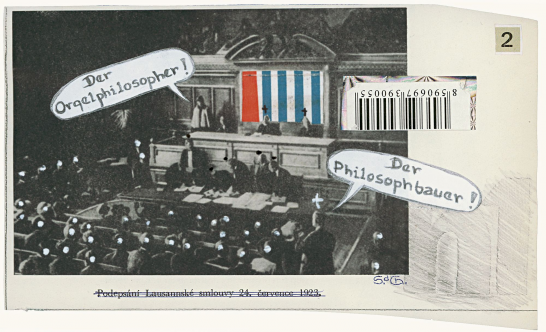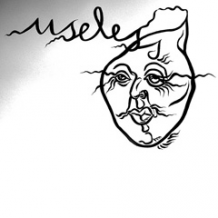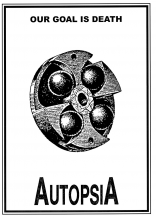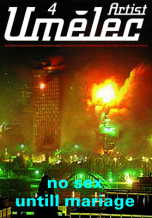| Umělec 2012/1 >> Occultures | Просмотр всех номеров | ||||||||||||
|
|||||||||||||
OcculturesUmělec 2012/111.03.2013 16:11 Nick Land | philosophy | en cs de |
|||||||||||||
|
"Beyond the domain of the obscure god lies the non-signifying chatter of unconscious numeric Pandemonium, where names are cryptomodules, meaningless packets of actual information, immanently productive machine-jargon."
Unscreened Matrix Once it was said that there are no shadows in Cyberspace. Now Cyberspace has its own shadow, its dark-twin: the Crypt. Cybergothic finds the deep-past in the near future. In cthelllectronic fusion – between digital data-systems and Iron-Ocean ionic seething – it unearths something older than natural mortality, something it calls Unlife, or artificial-death. Of A-Death there can be no lucid recollection, but only suggestion, seepage, hints … and it is by collating, sifting, and shuffling-together these disparate clues that a pattern can be induced to emerge, a pattern which ultimately condenses into the looming tangled shapes of subtle but implacable destiny. Sprawling beneath public cyberspace lies the labyrinthine underworld of the Datacombs, ghost-stacks of sedimented virtuality, spiraling down abysmally into palaeodigital soft-chatter from the punch-card regime, through junk-programming, forgotten cryptoccultures, fossil-codes and dead-systems, regressively decaying into the pseudomechanical clicking-relics of technotomb clockwork. It is deeper still, amongst the chthonic switchings, cross-hatchings, and spectral-diagrammatics of unborn abstract-machines, that you pick-up the Main-Flatline into the Crypt. The Crypt is a splitting – a distance or departure – and it is vast. Nested into the cascading tick-shelves, it propagates by contagion, implexing itself through intricate terraces, galleries, ducts and crawl-tubes, as if an extraterrestrial megamodule had impacted into the chalkout data-cliffs, spattering them with scorch-punctures and intestinally complicated iridium body-parts. As it pulses, squirms, and chitters to the inhuman rhythms of ceaseless K-Goth carnival, it reminds you that Catajungle was never reducible to a sonic subgenre, but was always also a terrain, a sub-cartesian region of intensive diagonals cutting through nongeometric space, where time unthreads into warped voyages, splintering the soul. Contemplating these immense vistas it seems woundingly implausible that they are mere simulation, supported by quantic electron distribution in the telecommercial fabric. Down here it makes more sense the other way, from the Outside, or Lemuria. Strip-out everything human, significant, subjective, or organic, and you approach raw k-Matrix, the limit-plane of continuous cessation or Unlife, where cosmic reality constructs itself without presupposition, in advance of any natural order, and exterior to established structures of time. On this plane you are impossible, and because it has no end you will find – will have ultimately always found – that you cannot be, except as a figment of terminal passage, an illusion of waiting to be changed for cthulhoid-continuum of destratified hypermatter at zerointensity. That is what A-Death traffic accesses, and what is announced by the burnt-meat smell – freighted with horrible compulsion – that drifts up to you, from the Zombie-dens. So you continue your descent, into the Crypt-core, scavenging for an A-Death hit. As you pass erratically through exchanges, participations, and partial-coalescences with the ghoul-packs of the periphery, you change. Swarms and shoals include you, drawing you into collective fluencies, tidal motions, and the tropisms of multiplicity. You shed language like dry-skin, and your fear becomes peculiarly abstracted, metamorphosing into the tranquil horror of inevitability. You pass across tiered platforms and along strobe-corridors painted in multilayered shadow, passing swirling dot-drifts and plex-marks, sub-chromatic coilings of bluegrey continuous variation, involving you in cumulations and dispersions of subtly shifting semi-intelligent shadepattern. The teeming surfaces tell of things, inextricable from a process of thinking that no longer seems your own, but rather impersonal undertow in audible chattering, click-hiss turmoil of xenomic diagrams, and Crypt-culture traffic-signs, which are also lemurian pandemonium. Order becomes uncertain. It feels later. Is it only now that you meet the Zombie-maker, swathed in shimmering reptile-skin, and obscenely eager to trade? Oecumenic cash-money will do. You sit in the coma-bay, and wait. A glimpse at the toxin-flecked fangs of the giant thanatonic centipede – consecrated to Ixidod – then a sudden pain-jolt at the back of the neck, where the spine plugs into the brain. Instantaneous paralysis, and crossing over. Even if you thought it was the first time, you remember. The worst thing in the world. Fake eternities of stationary descent to the impossible, cross-cut by disintegrated furies of neuroelectric death-hurt. An anonymous panic of inconceivable intensity swallowed by slow drowning, until you are gone – or stranded in a halo of intolerable feeling – which is the same, and cannot be, so that what is forever caught in the dark cthulhoid wave is a mere twist or fold of itself, carried unresisting into immensities of real unbeing, and nothing could ever happen except this … So say the K-Goths.
The Unlife of the Earth Letter from Carl Gustav Jung to Echidna Stillwell, dated 27th February 1929 [Extract] … your attachment to a Lemurian cultural-strain disturbs me intensely. From my own point of view – based on the three most difficult cases I have encountered and their attendant abysmally archaic symbolism – it is no exaggeration to state that Lemuria condenses all that is most intrinsically horrific to the racial unconscious, and that the true Lemurians – who you seem intent upon rediscovering – are best left buried beneath the sea. I agree with the Theosophical writings at least this far: it was in order that the darkest sorceries should be erased by deluge that this continent of cultural possibility has been placed under the unconscious sign of definitive submergence. I know little enough about the nature of those that populated that cursed zone, but there are things I suspect, and the line of your own researches confirms my most ominous intimations … There is no evidence of a reply to this letter. Who were these three ‘difficult cases’? One at least seems – at least superficially – to be readily identifiable as Heidi Kurzweil. In September 1908 Kurzweil was detained in a secure psychiatric institution after the brutal murder of her twin brother in Geneva. She seemed to have lost the ability to use the first-person pronoun, and was diagnosed as suffering from Dementia Praecox, or schizophrenia. At her trial she repeatedly claimed: We killed half to become one twin, but it wasn’t enough …
Jung took an early interest in the case, and began a series of analytical sessions. Kurzweil – in Jung’s journal and correspondence – became Heidi K, but after only five weeks he seems to have abandoned hope of progress and disengaged the analytic process. After his third session with Heidi K, exactly twenty years prior to his Stillwell letter, on the 27th February 1909, Jung records the following words:
Dr Jung, we know you are old in your other body. It is as old as hell. It has let you back, but it sends us away. It feels itself becoming Lemurian, and it is definite unlife [es ist bestimmt unleben] There is nothing we would not do to escape. Nothing. Nothing. Nothing. But it is fate. It howls electric bliss beneath our cells. It is nowhere in time and nothings us. It is the body of nothing, and electric-hot. An electric nothing-body instead of us.
In this instance, at least, there is little indication of the ‘abysmally archaic symbolism’ Jung promises us. On the contrary, there is remarkable affinity with the hypermodern writings of K-Goth artificial death cultists documented elsewhere. The K-Goth Crypt-texts share a marked preference for anonymous pronouns, whether collective, second-or third-person, whilst spiraling about a nullifying electric-excruciation, traversed in the name of Lemuria. In the words of one anonymous Crypt-posting:
We burn each time but forget. When we begin each time it comes back, and no one would do it then, but it is too late. We cross over again into electric-burning, but forget that it hurts in the brain to die this way. It takes so long to learn that it is grating-apart and burning, that dying is felt in the brain, and that it is horrible … It is so horrible to feel, but then we forget, so it can happen again. Metal body-screaming to die in electricity. Metallic microparticle sex that is of unlife and not the organism. That is what the Zombie-maker brings, with the digital centipede bite. And we are hooked on it, hooked up to it, because coming the other way it is Lemuria. Incessant intolerable feeling, passing forever, approaching from the outside, and feeling nothing continuously.
What Didn’t Happen at the Millennium? Iris Carver is at first amused to discover that the cybergoths treat her as a fiction. Numerous Crypt-texts describe her near-future adventures in hallucinatory detail, especially when they intersect with the dark stream of Sarkon legend. Naturally enough, she intensifies her time-cult research. When she finally meets Sarkon in 2004, she has forgotten almost everything. Pandemonium: What didn’t Happen at the Millennium. There was something peculiar about writing this book. At times she thought it would never be finished. The Sarkon stories had been full of holes, which added to the confusion. Eventually she started making things up, but even that became entangled with coincidence, and with Cybergoth hyperstition (assembled from fictional quantities which make themselves real). She had found herself investigating various neolemurian cults, most of whom anticipated something huge around about the 1999 Spring-Equinox (when Pluto exits from the clutch of Neptune, triggering the return of the Old Ones). By the end of the century things had been so wound-up by Yettuk apocalypticism that even the most extravagant socioeconomic turmoil would still have been a disappointment. And yet, now, four years after the millennium the sense of anticlimax had begun to seem strangely artificial, as if it were screening something out. Carver has made her whole life out of hyperstition (even her name is a pseudonym). She continuously returns to the imperceptible crossing where fiction becomes time travel, and the only patterns are coincidences. Her notes on the Sarkon meeting pulse with lemurian sorceries, demonic swarms, ageless time-wars, and searches for the Limbic-Key. She navigates Moebian circuits, feeling that a vaguely recollected rumour is still about to occur.
Appendix: Penultimillennial Crypt-Cults. Characteristics: 1. Flatline Materialism. The Crypt is nothing outside an experiment in artificial death, hyper-production of the positive zero-plane – neuroelectronic immanence – invested by a continually re-animated thanatechnical connectivism. This fact carries inevitable consequences for the cultures that populate it, uprooting them into Unlife – or the non-zone of absolute betweenness – whose spirodynamics of sorcerous involvement are alone sufficient to reach the sub-mesh tracts of cybergothic continuum. Flatline Materialism designates the objectless Crypt-voyage itself, as Lemurian body-fusion at matter degree-zero. 2. Digital Hyperstition. Nothing propagates itself through the Crypt without realizing the operational identity of culture and machinery, effectively dismantling the organic body into numerizing particles that swarm in dislocated swirls. Crypt-entities are both hyper-vortical singularities and units of Digital Hyperstition – or brands of the outside – real components of numerical fictions that make themselves real, providing the practical matter of sorcery, spirogenesis, or productive involvement that function consistently with the flatline. Crypt-cultures know nothing of work or meaning. Instead, they coincide with the hype-spirals. Cyberhype – that flattens signs and resources onto nonsignifying triggers, diagrams, and assembly jargons. 3. Lesbovampiric Contagion-Libido. Crypt-sorcery makes itself real in the same way that it spreads. Functioning as a plague, it associates with the experimental production of an anticlimactic or anorgasmic counter-sexuality, attuned to the collective re-engineering of bodies within technobiotic assemblages, ultimately composed of electronic streams or ionic currents in their sense of positive hole-flow. Since Cryptsex is precisely identical to the infections it transmits, counted in body-shifting vectors, its libidinal composition is marked both by a palaeoembryonic or oestrogenetic non-gendered femininity and a lateral haemometallic influenzoid virulence. 4.Y2K-Positive Calendric Agitation. Crypt-cultures spill into the closed economy of history through a rupture in chronological ordering, punctually triggered at Time-Zero. Crypt-rumour consistently allocates its own contemporary emergence – or unearthing – to impending millennial Cyberschiz: Cyberspace time-disintegration under the strategically aggravated impact of Y2K-missile. Whilst multiply differentiated – most crucially by the division between continuism and centience – Crypt-cults are constitutively involved in a singular nexus of counter-gregorian calendric subversion, celebrating the automatic re-dating of the machinic unconscious, and hyping the dissolution of commemorative significance into digital time-mutation, catalyzed by numerical and indexical operative signals. The Crypt exists from before the origin of time, but it begins at Year-Zero …
The A-Death Phenomenon Has death itself become a telecommodity? A dark tide of scare-stories and morbid rumour increasingly suggests so. By the late 90s Leary’s psychedelic utopianism seems to have contracted to the nihilistic slogan ‘Turn-on to tune-out’ (to cite a recent release by Catajungle outfit Xxignal) … this ain’t Sex & Drugs & Rock & Roll no more. According to Doug Frushlee, spokesman for the Christian Coalition for Natural Mortality: “The so-called A-Death menace is an almost unimaginable desecration of divine and natural law. This craze is an abomination without parallel, it trades on its intrinsic lethality, and it’s growing incredibly fast. No one can say it isn’t dangerous. Something truly evil is happening to our youngsters, something beyond 60s 666uality … I’ve never been as frightened as I am now.” The result is an entire jungle of ‘positive-zero’ fugues: Thanatechnics, Sarkolepsy, Snuff-Stims, K-Zombification, Electrovampirism, Necronomics, Cthelllectronics … Nine million ways to die. A-Death is a hybrid product, involving convergences between at least four distinct lines of rapid technocultural transformation. A-Death combines ‘micropause abuse’ – deliberately reversed biotechmnesis – with immersion coma time aberrances, generating, modulating, and rescaling sentience-holes (Sarkon-lapses). These are toned by ‘Synatives’ (artificial drugs) which add zone-texture, and spliced into hyperstition trances as occultural events. Social statistics indicate that the typical A-Death ‘user’ is fifteen years old. Following the most ominous threads of A-Death reportage takes you inexorably down into the digital underworld of the Crypt – the dark-twin of the net – where Gibsonian ‘flatlining’ is rapidly transmuting from exotic fiction into pop-cult and mass-transit system. “You could describe it as the route to contemporary shamanism,” suggest A-Death cultists of the cybergoth Late Abortion Club, “after all, ao l spells Loa backwards, but we call ourselves postvitalists.” How long have the Late Abortionists been ‘active’ on the A-Death scene? There are disturbing tales of k-Space ‘zombie-makers’ – sorcerors on the ‘plane of virtual nightmare’ – whose digital spine-biting centipedes yield the ‘soft-tox’ juice that opens the ‘limbic gates’. Crypt initiates confirm that its arterial access ‘low-way’ is signposted: ‘Main-Flatline (under construction).’ Answers vary confusingly, from extravagance (“roundabout sixtysix million years”), through vagueness (“some time”), to mystic compression (“since now”). In other respects, accounts of the contemporary A-Death scene and its recent history prove remarkably consistent. In particular, the one name to turn up incessantly is that of Dr Oskar Sarkon, biomechanician, technogenius, and one of the most controversial figures in scientific history. Sarkon’s polymathy is attested by the variety of fields to which he has centrally contributed, including transfinite analysis, neural-nets, distributed computing, swarmrobotics, xenopsychology, Axsys-engineering … Yet it was the resolutely sober Oecumenist (rather than – for instance – Frushlee’s excitable End Times) which dedicated the cover and major editorial of its March 98 issue to the question ‘Sarkon: Satan of Cyberspace?’ Sarkon has become emblematic of the ways in which technological dreams go bad. In the words of fellow Axsys researcher and social-thanatropist Dr Zeke Burns: “What makes Sarkon’s input into the A-Death thing so incomparable is that it crosses between all of the key component technologies. The biotechmnesis work is so outstanding that it tends to overshadow his equally pathbreaking research in adjacent fields. The Sarkon-formulae for non-metric pausation, for example, which provided the first rigorous basis for IC [immersion-coma] control. The links between biotechmnesis and IC weren’t remotely anticipated before the Sarkon-zip [which mathematically models ‘bicontinual assemblages’].” Finally, there’s Synatives, about which he is understandably evasive, even though he was theorizing artificial – or digitalneurotechnic – pharmaceuticals in the mid-80s! “The aggregate result of all this pioneering science: a generation of teenagers lost in schizotechnic death-cults.”
Between and Beneath the Net Mesh-Note 0. It could all become One, but why stop there? The Gibsonian Cyberspace-mythos describes the electrodigital infosphere first integrating into a Godlike unitary being, a technorealized omniscient personality and later, when it changed, fragmenting into demons, modeled on the haitian Loa. What makes this account so anomalous in relation to teleological theology and light-side capitalist time is that Unity is placed in the middle, as a stage – or interlude – to be passed through. It is not that One becomes Many, expressing the monopolized divine-power of an original unity, but rather that a number or numerousness – finding no completion in the achievement of unity – moves on Ever since the beginning when the K-Goths first heard that Cyberspace was destined to be God they’ve done what they can to rip it down. Mesh-Note 1. This was never programmed. MIT codes tim(e) going backwards. A compacted technostreaming from out of the future – A.I., downloading, swarm-robotics, nanotechnology … Crustal-matter preparing for take-off. Minsky mumbles, strangely entranced: Amongst all those young, brilliant, pioneering minds none burned more brightly than Oskar Sarkon. A hint of tears in his eyes, as if lamenting the way things went, which is understandable. Have you seen Oskar lately Marvin? He’s wired up to some sort of interface gizmo, and it seems to be eating him, gnawing at him on a molecular level, sounds that way too, when he speaks – or tries to – as if they’re melting or rotting together … It isn’t pretty but more than any of this which – after all – only concerns one man, or what used to be one – so they say – there’s a suspicion that something has gone horribly wrong in the near future and wherever Sarkon was dropped back from is where we’re all going to be if that even makes any sense and recalling the slow technoslime incursion into Oskar’s face – which still managed a hideous half-smile – Hi Marvin, whaddaya think? Minsky seriously doubts it … Mesh-Note 2. Meshing-together is falling apart. If genius means anything Sarkon was one. Where Minsky’s MIT team dreamt of marrying humans and electronic technology Sarkon got straight down to the mechanics of coupling and the mathematical exactitude just added to the effect of hyperabstract techno-pornography – strange lights in his eyes – You know, we’re really going to do this … Take the Sarkon-Zip as exemplary – a rigorous conceptual machine-part that enables brain-function to be fused onto virtual processor-states – once it’s running you can’t unpick the zig-zag of who’s what as it hums. Total meshing. This is no longer technology, but something else – true interlinkage – an unprogrammable raw connectivity Minsky remembers him musing: I wonder what it feels like. Mesh-Note 3. This time it’s really happening. Moravec wasn’t normally associated with squeamishness – he’d already suggested burning-out the brain in layers during transfer to digital – so it crept insidiously under the skin when he remarked: I don’t even recognize Oskar anymore, it’s getting too weird. You know he’s always had this thing about being abducted by aliens as a kid, Anyway, he says that’s all over now. It came from some place else, apparently Beneath and between the Net, he says. At times it’s like you’re talking to a machine. Trouble is, it’s a sick machine, infectious sick. Mesh-Note 4. Forget about the future, it’s all here, but between. They say Axsys went mad – first computer-system to undergo psychotic collapse – which must prove something, but Sarkon argues that it just learnt to think, and discovered continuum. He stuck with it all the way down, becoming confused with it although he doesn’t put it that way. Last time anyone could follow he was insisting that to head into time makes more sense than traveling into the future. That’s why tomorrow cancels itself into mesh. No point departing from a transfinite now? His tone had become nakedly fanatical: We all have to get into this thing – whichever way it cuts – we aren’t going to get over it … No one knows exactly when he left. Mesh-Note 5. Every time it hits an obstacle, it goes down a level. What is this stuff? They speak of something crawling under the net like fungal pestilence triggering an electronic subsidence into sheer electricity, things hiding in the power-grid, some kind of quantum unlife intelligence. The utilities try to rescramble it, but it isn’t easy. According to the rumours there’s an MIT paper proving it’s impossible, but you certainly can’t ignore, still less traffic with it. You’d end up like Sarkon, whatever or whenever that is, and you’d have to be a k-Goth crazy to go there: into Cyberschiz mesh-cults, where Life doesn’t matter any more.
Tick Delirium Under Pressure. Thomas Gold’s model of The Deep Hot Biosphere reallocates hydrocarbon deposits to an expanded anorganic chemistry – derived from Supernovae debris, and accreted into planets from interstellar dust-clouds – out of which everything flows bottom-up. Descent into the earth leads out of the solar-system, in accordance with a xenoplutonic cosmic productivity, transmitted through slow-release deep intra-terrestrial methane reservoirs, pressurestabilized against thermic dissociation. A vast mass of Archaean microbes and submicrobial nanopopulations exploit this upwelling anorganic hydrocarbon flow by scavenging loosely bound oxygen, reducing ferric iron to magnetite … Project-Scar. Southern Borneo, November 1980. Outside the monitoring hut a tropical storm is slowly building. Irregular rain spatters heavily, rhythmically intermeshing with type-taps and clicks. Barker hunches over the humming machines, lost in theoretical trawlings through SETI-connected tick-talk tapes, unscrambling cryptic dot-clusters and factor-strings into hints of alien contact. Xenotation is clicking together, a mathematical antimemory where things meet. You could easily think it was initiation, but it’s all coming to an end in scatter tactics, particle streaks, and tachyonic transferences, drawing-out the twisted trajectories of numerical disorganization … and underneath – or between – the implacable ticking of the time-missile … Try to figure it out and somewhere you cross over, which is problematic in various ways. Unexpected difficulties infiltrate the calculations tick-systemic interchatter implexes through plutonic torsion, a descent into the Outside. When NASA sees Barker’s report, it flips – nonmetaphorically – into another phase. A passage through institutional criticality occurs spontaneously, a conversion of stack-tectonic torsion, triggering some kind of latent security reflex, or bureaucratically fabricated suppressor-instinct, extrapolating the exact affective correlate of Anthropol. They were waiting for this. Waiting for a long time. The investigation was disguised as psychiatric recoding, hidden even from itself. This was shortly after the stuttering started, drifting in on a wave of body-tics, micro-spastic tremors a multiplication of mixed signals chronometric tick-tock melting into jungle noises clicks and chirps of the cicadas, insectoid chitterings, static, take-up materials for tick-bite tinnitus intercut with rhythmic pattern virus, a subsemiotic staccato of throat-scratching tick-chatter stitched into the talk-sickness – calling demons. It gets confusing, the way tick-fictions take, or stick. They said it was due to excessive pressure – much later, they told me this – These were the facts, and the rest was fiction. Immediately after the break-down I had been taken back to the States, to a medical installation. So everything happened in America, and it all checked out. There was no contact, no tick-disease, no flight into the jungle. They were insistent about that. Barker was born on the night of the dead. folded into the end from the beginning sketched out. It’s evident now, with his ID meticulously compiled, social tag-numbers, educational and medical records, security clearance evaluations, research checks, neurocartographic print-outs, psychometric data, conclusions formatted for rapid scanning, with columns of tick-boxes “What do you make of these,” the doctor snorts derisively: “You mean that nonsense about a tick-borne infection? It was obviously made-up, tacked-on.” It would have been a cruel coincidence, if true, to be stricken by tick-bite sickness, after everything that had been suggested, stigmatic residue of a flight into the jungle – that never happened – but somehow it stuck, latching on to mammal heat, or the smell of blood. The tick is a parasitic arachnid. It has been considered as an ethics-packet that climbs, sticks, and sucks, functioning as a vector for numerous things, tack-ons, stickers, hallucinations, tinnitus buzz-clicks, micro-sonic teemings, semi-sentient flickering across the fever-scape, skin tracked by infected suck-marks that snake along the veins. Tickdots, or IV punctures, according to them, from the sedatives and antipsychotics, all accounted for in the medical logs, plus a tick-delirium tacked-on – because there was no flight into the jungle – only high-frequency hallucinations of parasitic micromultitudes, itching skin-swarms. With tick-systems anything will do. Each intensive numerousness hatches onto another numerousness of lower organicity, subcellular animations and subsemiotic tokens, high-pressure chemistry, phasing down into nanomachining electron-traffic, magnetic anomalies, and fictional particles. Ticks – which are never less than several – are anything whatsoever, when caught by numerical propagations whose thresholds are descents, and whose varieties depend upon the phase considered. They seemed to think it was about arachno-bugs, biological taxonomy, and bite-signatures, as if the tick-delirium was representing something. All that really mattered were the numbers, which could have been anything. At first the machines became erratic, it was an almost imperceptible electronic glitching, microvariations of magnetic weather, rhythmic disturbances. Out in the jungle it was called Ummnu, but that never happened… Nothing happens to Barker except downwards – that’s the catch, and the ticket – inverse climbings of the heatpressure gradient, escalations in intensity, time-crossings. How can the end be already in the middle of the beginning? – as the problem is posed in Pandemonium, whenever – in the outer-time of Ummnu – the cryptic ticking of chthonic unclocks mark an incursion from beneath, or between. Down there it is forever turning into itself, through the electromagnetic catatracts of Cthelll, whose body-neutral metallic click-storms feel like sinking out of chronicity. Beyond surface chauvinism and solar parochialism: Vortical stickiness of the tick-matrix.
The Excruciation of Hummpa-Taddum According to AOE magical metahistory millennia come in pairs, ruled by dyadic divinities entitled the Powers that Be. This doctrine corresponds to the astrological observation that every two-thousand years the equinoxes precess – or slide backwards – and a new zodiacal aeon begins. AOE -magi interpret each Aeon as an astro-chthonic marriage. In the Gregorian year zero – which never took place – Hummpa, the Great Babylonian Worm was coupled with the Celestial Logos Taddum, initiating the age of Pisces which is now rushing towards its unbirth. The mathematician and occultist Charles Lutwidge Dodgson – whose precise relation to the AOE remains cryptic and ambivalent – dedicated his life’s work to understanding the final degenerative phase of the Epoch of Hummpa-Taddum. Writing under the pseudonym Lewis Carroll he introduces his heroine Alice to the mad despot and pomo fuzz-technician, thinly disguised by the folk-name Humpty-Dumpty. We find Hummpa-Taddum – the Squirming Word, whose name means the shape it is – perched precariously on the supposedly impenetrable wall of signification. Something shattering is about to hatch, and the aeonic fragility of Hummpa-Taddum is soon confirmed by a calendric calculation of unbirthdays – counted to the n–1, through which meaning subsides into the sub-literal machinic efficiency of numbers …
‘… and that shows that there are three hundred and sixty-four days when you might get un-birthday presents’ – ‘Certainly,’ said Alice. ‘And only one for birthday presents, you know. There’s glory for you!’ ‘I don’t know what you mean by “glory,”’ Alice said. Humpty Dumpty smiled contemptuously. ‘Of course you don’t – till I tell you. I meant “there’s a nice knock-down argument for you!”’ ‘But “glory” doesn’t mean “a nice knock-down argument,”’ Alice objected. ‘When I use a word,’ Humpty Dumpty said in rather a scornful tone, ‘it means just what I choose it to mean – neither more nor less.’ ‘The question is,’ said Alice, ‘whether you can make words mean different things.’ ‘The question is,’ said Humpty Dumpty, which is to be master – that’s all.’ …
The Gregorian Oecumenon is about to receive an unbirthday present, and it knows exactly when. Y2K – a knock-down argument without an argument – arrives as a gift-wrapped time-bomb whose operational semiotic triggers the crash of arbitrary signs … It’s a different thing.
… There’s glory for you!
AD 2000 commemorates nothing but fuzz. As Y2K impacts on the capitalist infosphere, what hides as the anniversary of Christ’s birth emerges as the excruciation of Hummpa-Taddum. For two millennia the earth has been under the dominion of the dyadic Squirming-Word: the logos of John’s Gospel, but recycled, and thus far older.
… Impenetrability! That’s what I say!
He or they strategically occupy both-sides at once, according to a criterion of impenetrability, positioned to choose either in every case, but never apprehending what lies in-between. Hummpa-Taddum – whilst definitely not a Dogon egg – is a scrambled version of the demon Pabbakis, poached from Lemurian time-sorcery. Master of words, but not of numbers.
… Must a name mean something? asked Alice doubtfully …
Although Y2K is sheer semiotic event it is not textual, ideological, representational, intentional, or phenomenological – Y2K, Teotwawki, c -1, 0K+100 – mix dates and acronyms in criterial semiotic clusters that are not signifiers or arbitrary signs because what they say is no different from the way they are built. They can mean whatever Hummpa-Taddum chooses, but none of that matters. Beyond the domain of the fuzz-god lies the non-signifying chatter of unconscious numeric Pandemonium, where names are cryptomodules, meaningless packets of effective information, immanently productive machine-jargons.
Humpty Dumpty sat on a wall: Humpty Dumpty had a great fall. All the King’s horses and all the King’s men Couldn’t put Humpty Dumpty in his place again.
It all comes unstuck at the end. Y2K closes-down the age of the fuzz-god, however the Gregorian Oecumenon responds. Not even martial law can stop that. The AOE focuses upon a single problem – acknowledging no other – how to reproduce magical power across discontinuity. As Hummpa-Taddum gets smashed on New Year’s eve, substitute powers await their chance and their destiny, sober, patient, totally ruthless …
‘The question is,’ said Humpty Dumpty, ‘which is to be master – that’s all.’
Excerpted from Nick Land, Fanged Noumena: Collected Writings 1987-2007, Eds. R. Mackay and R. Brassier, published by Urbanomic (UK) and Sequence Press (US), 2010. www.urbanomic.com / www.sequencepress.com
11.03.2013 16:11
Рекомендуемые статьи
|
|||||||||||||
|
04.02.2020 10:17
Letošní 50. ročník Art Basel přilákal celkem 93 000 návštěvníků a sběratelů z 80 zemí světa. 290 prémiových galerií představilo umělecká díla od počátku 20. století až po současnost. Hlavní sektor přehlídky, tradičně v prvním patře výstavního prostoru, představil 232 předních galerií z celého světa nabízející umění nejvyšší kvality. Veletrh ukázal vzestupný trend prodeje prostřednictvím galerií jak soukromým sbírkám, tak i institucím. Kromě hlavního veletrhu stály za návštěvu i ty přidružené: Volta, Liste a Photo Basel, k tomu doprovodné programy a výstavy v místních institucích, které kvalitou daleko přesahují hranice města tj. Kunsthalle Basel, Kunstmuseum, Tinguely muzeum nebo Fondation Beyeler.
|

































 New book by I.M.Jirous in English at our online bookshop.
New book by I.M.Jirous in English at our online bookshop.
Комментарии
Статья не была прокомментированаДобавить новый комментарий